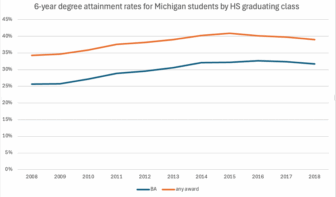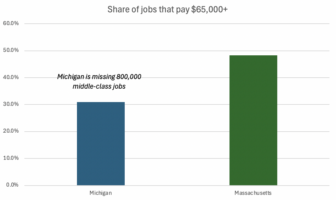A central theme of ours is that economic growth is increasingly being driven by big metropolitan areas anchored by vibrant central cities. These are the places where both knowledge-based companies and college educated adults are concentrating. And the places where they concentrate are the most prosperous in the country. Where personal income is the highest, importantly for both college educated and non college educated workers.
So for Michigan to return to prosperity it is essential that our big metros – most importantly Detroit (including Ann Arbor), but also Grand Rapids and Lansing – need to be talent magnets. Places where college educated adults choose to live and work. And this needs to be a priority for state and regional policymakers and economic developers.
For those interested in both the future of our economy and the importance of central cities I highly recommend three new books:
Triumph of the City by Edward Glaeser. If you choose to only read one book about the economy, this is the book I recommend. It simply presents the best analysis of what drives economic growth in a flattening world and the growing competitive edge that makes big metropolitan regions with large talent concentrations (you need both) the places where that growth is concentrating. And it is not just economic growth that do better in central cities. The book’s subtitle is: How our greatest invention makes us richer, smarter, greener, healthier and happier. The great invention he is referring to is, of course, cities. The book concludes with a terrific chapter on what policy makers need to do to reverse the long standing anti-urban, anti-density bias that harms our cities, our environment (yes dense cities are the greenest places) and our economy.
Alan Ehrenhalt, former executive editor of Governing magazine, has written a terrific book about the growing demand of the affluent to live in central cities entitled The Great Inversion. Most of us in Michigan continue to view cities as, at best, relics of the past. Places where maybe the grandparents of folks like us use to live, but now the places where only the poor and low educated immigrants live. Think again! As Ehrenhalt demonstrates a demographic inversion in taking place across America. Central cities are increasingly the place where the affluent want to live, particularly college educated Millennials. The book describes the features that make central cities attractive – largely walkable urbanism with access to light rail transit – to the affluent and what cities across the country – driven in many places by business leadership – are doing to meet that demand. Lessons we are having trouble learning here in Michigan.
Finally, Enrico Moretti’s The New Geography of Jobs. Consistent with Glaeser, Moretti makes a compelling case that the driver of economic growth is innovation, which he calls the new engine of American prosperity. The data he presents makes clear that innovation jobs are concentrating in what he calls brain centers – largely big metros with high talent concentrations and mid sized metros with research universities. And that in those brain centers everyone’s wages go up. Certainly knowledge workers, but also non-college educated workers. For example, in metro Flint the average wage for high school graduates is a little less than $29,000, for those in the same occupations in Lincoln, Nebraska the average wage is a little less than $42,000. The main difference between the two regions? College attainment: 38% in Lincoln, 12% in Flint. So one has a knowledge-driven and therefore growing and high wage economy, the other doesn’t. Maybe most importantly, he provides a compelling answer to the conundrum as he puts it of “Companies appear to locate in absolutely the worst places: they pick very expensive places – the Bostons, San Franciscos and New Yorks of the world.” Moretti explains why concentrated talent which produces productivity and creativity is what characterizes the economic geographic winners, rather than low labor, real estate and tax costs.






